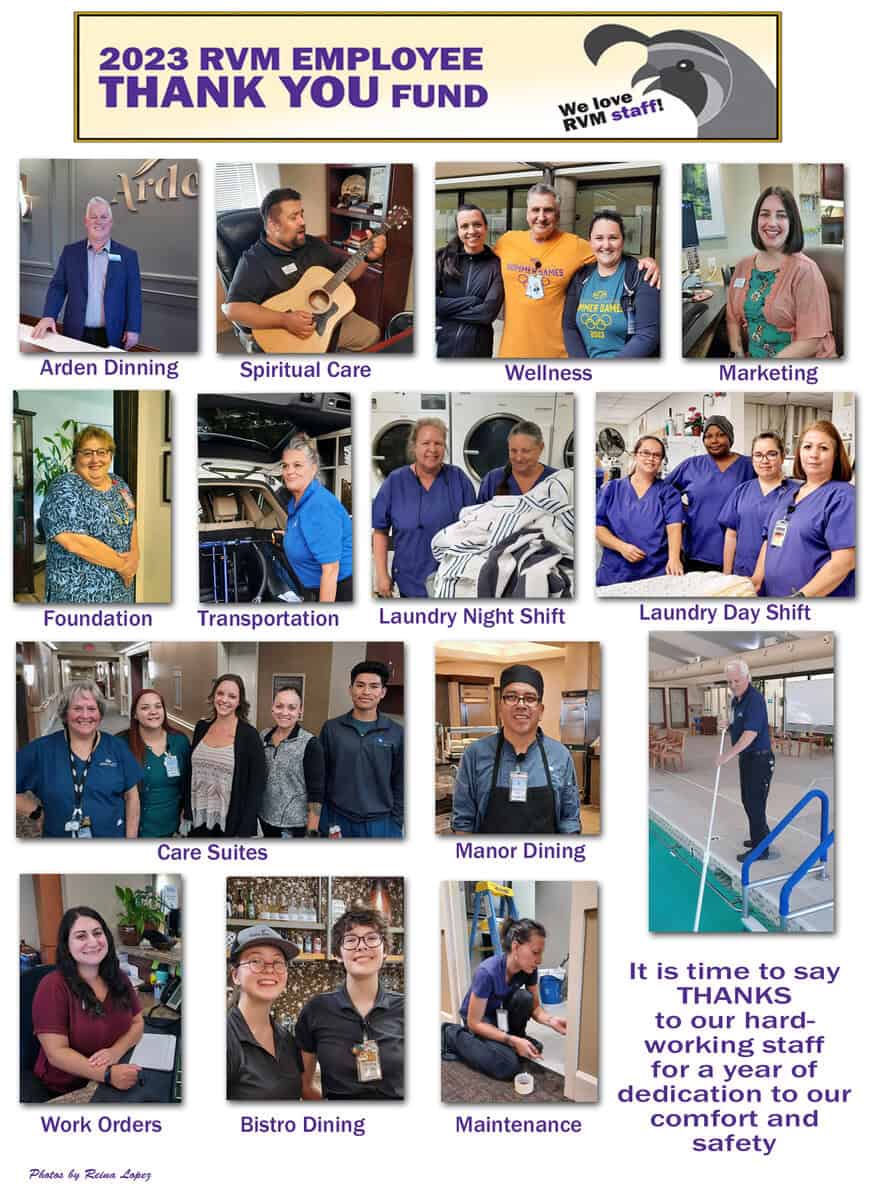Posted in N&V
Traveling the Challenged Way
By Joni Johnson
I have a long-term friend who has had serious back issues for a number of years. She loves to travel, but the way she coped with the situation was to go on trips where her husband would walk or hike or take in a museum and she would sit on a bench waiting for him to come back from his excursion.
Within this past year, she has found a brilliant solution to this problem. Instead of sitting on the sidelines, she rents a scooter and has access to the kind of travel she has always enjoyed. She is happy. Her husband is happy. This article will share the what, wheres and hows of her latest travel adventures.
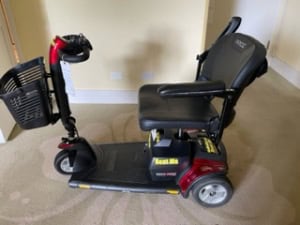
Her first rental scooter
Jackie’s first scooter adventure was on the island of Oahu where she and her family including kids and grandkids stayed for a week. The resort at which they were staying was very large and would have required a lot of walking just to get around. Jackie found Cloud of Goods https://www.cloudofgoods.com and rented a three-wheeled scooter. The site offers all sorts of mobility equipment from light-weight to heavy-duty scooters to regular and electric wheelchairs, strollers and medical equipment for the house. Here is an example of the scooters they offer. https://www.cloudofgoods.com/product-rentals/mobility-scooters. They will deliver and pick up your rental to the same place (your home or most hotels). In checking around on the site, I found they work with places in Mexico, all over the US, and even the UK. Canada didn’t work. Nor did France, but I imagine this changes with dates and cities. The prices can change, but for Jackie, rentals in Hawaii, Mexico, New York and Oregon all cost $50 a day.
Her second voyage was to Mexico for a wedding, again at a large resort. This time, she rented a 4-wheel scooter because she felt more stable. She even tried to take it to a ruin not that far from the resort, but it was too rocky. Otherwise, it worked perfectly, taking her across the half-mile campus easily.
On her latest journey, she decided to go with a heavier duty scooter which might travel 15 miles rather than 7.5 miles. It still only cost $50 per day. In New York City, she was able to visit all the major museums, Chelsea market, Central Park, restaurants and even Times Square, although the crowds on the square made maneuvering a bit difficult. The only time she didn’t use her scooter was going to plays because it was just as easy to take an Uber or Taxi and a cane and be dropped off right in front of the theater.
There is a taxi-hailing app called Curb that offers a variety of taxi types including those that can carry mobility equipment. They operate out of New York, Chicago, Philadelphia, Washington DC, Miami, Ft. Lauderdale, San Jose, and Los Angeles. https://www.gocurb.com They have an App similar to Lyft or Uber, so that all info including payment is done online. However, in other cities you can also request a van-type taxi that will be able to transport you and your scooter or wheelchair wherever necessary. You just need to ask!
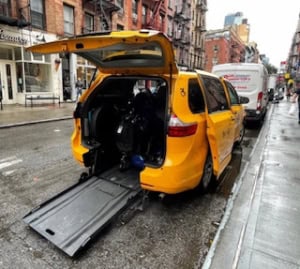
Taxi pickup with Curb
Most scooters include the front basket, which is very convenient. There are other accessories that may or may not be included in a rental (but you might be able to request them). If buying, consider which accessories you may want and make sure that they fit securely on the model of scooter you’re buying.
- A front light.
- An “out-of-the-way” horn (Just a quiet “beep” but you could always get a louder bicycle horn and attach it yourself). There were times when she wished she had a megaphone to shout “OPEN YOUR EYES” to people walking obliviously, cutting in front of her.
- A cup/water bottle holder and/or phone holder, one that is mounted on the stem of the steering column right in front of the rider is best. There are some that attach to the armrest or to the side of the steering wheel, but I would think that those are more prone to someone snatching your phone.
- A rear-view mirror.
- A detachable sunshade or canopy.
She rented a heavy-duty four wheeled scooter in Oregon so that she could travel uneven paths viewing water falls.
This is the four-wheeled scooter that she had in Oregon. It was heavier, but sturdier. It felt much more secure traveling slightly uneven paths viewing waterfalls.
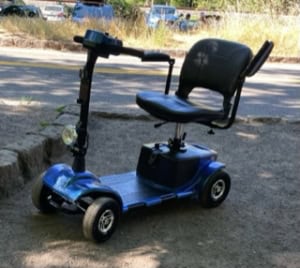
The heavy duty Oregon scooter
If you already own a wheelchair and are used to traveling with it, that will probably work well for you. However, if you’re making decision whether to rent a wheelchair or a scooter, Jackie recommends the scooter. It’s easy to maneuver, and, if some oblivious person walks into you, you have less chance of being hurt since you have the steering column in front of you. It also has the advantage of the front basket so that you can keep an eye on your belongings; the basket or storage organizer on a wheelchair is usually behind the seat, giving pickpockets easier access.
For even more information, Jackie recommended a blog by Cory Lee who talks about the world of travel using a wheelchair. In his blog he talks about a host of places he has been and discusses things like How can I fly as a wheelchair user? Which hotels are the most accessible? What beaches have powered beach wheelchairs? How do I charge my wheelchair in a foreign country? What cities are the most wheelchair friendly around the world?
Welcome – Curb Free with Cory Lee: A Wheelchair Travel Blog
 Cory Lee |
So serious traveling while dealing with physical mobility issues can be a reality. Do your research ahead of time. Google the name of the city you plan to visit and “accessibility.” You’re likely to find several sites that will help you decide your itinerary. Try it once and see how it can transform your life.
Senior Solitude — AN ESSAY
By Bob Buddemeier
Background — Topic
Alone. Solitary. Isolated. Search for those terms in the context of health in old age, and you will find general disapproval. Some of the advice is phrased judiciously –
“For older adults, social connection is particularly important to reduce risk factors such as social isolation and loneliness. At this stage of life, meaningful social activities can significantly improve positive mental health, life satisfaction and quality of life; they can also reduce depressive symptoms.”(1)
Other sources are more blunt about the necessity for social contact, to the point of portraying self-isolation as an antisocial act —
“Yale University professor Dr. Laurie R. Santos asserts that the ‘sheer amount of time we spend around other people predicts how happy we are.’ Mistakenly seeking self-isolation and convenience in our routines is hindering our ability to build social capital in our society.”(2)
My personal happiness is definitely not positively correlated with amount of social contact, and this essay is my effort to develop a more realistic view of the subject for older people, senior living residents, and RVM in particular.
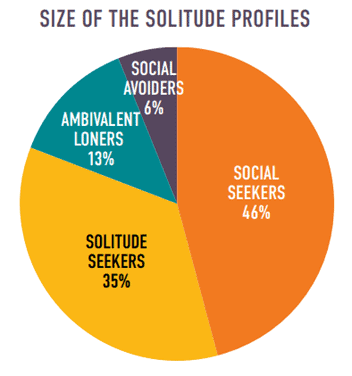 Susan Ball recently circulated on RVMlist the abstract of a study entitled Seeking Solitude – Motivations for “Alone Time” among Senior Living Residents(3). It is concise and eminently readable, and you can read or download a pdf by clicking the linked title above. What follows will be my impressions and interpretations of the data and related information, including quotes and figures from the report. When I intersperse personal experience or unverified opinions, I will use bold font.
Susan Ball recently circulated on RVMlist the abstract of a study entitled Seeking Solitude – Motivations for “Alone Time” among Senior Living Residents(3). It is concise and eminently readable, and you can read or download a pdf by clicking the linked title above. What follows will be my impressions and interpretations of the data and related information, including quotes and figures from the report. When I intersperse personal experience or unverified opinions, I will use bold font.
The bottom line of the published study: “Positive motivations for solitude are unlikely to pose risks for older adults and are associated with well-being comparable to people who prefer greater levels of social interaction.”
The study population of 397 individuals residing in senior living facilities was surveyed to assess eight different wellness parameters as well as the extent of positive or negative motivations for solitude. The participants were classified into one of 4 categories (as seen in the pie chart).
Slightly fewer than half of the participants were classified as Social Seekers. The remainder were classed into three categories – Solitude Seekers (a little over a third of the total) and two other smaller categories that scored lower on the wellness assessment, Ambivalent Loners and Social Avoiders.
The comparison of wellness assessments for the four groups is illustrated in the following table. The empty cells indicate no significant differences; in the green cells the arrows show the between-group comparison, with an up-arrow meaning “greater than.” Note that all of the characteristics are desirable except for loneliness; in that case, unlike the others, the down arrow is a positive result.

The Solitude Seekers apparently experience greater well-being than not only the 19% of the population whom I’ll call “unhappy loners,” but also the Social Seekers – Solitude Seekers score higher in Personal Growth and Psychological Richness, with the other categories lacking significant differences.
The 35% value for the proportion of the study population who are Solitude Seekers matches well with the statement from the dust jacket of Susan Cain’s book QUIET – The Power of Introverts in a World That Can’t Stop Talking (4): “At least one third of the people we know are introverts.”
Although “introvert” and “extrovert” are labels that cover diverse groupings of many different conditions, I will treat Solitude-Seekers and Introverts as different labels for the same or strongly overlapping populations. This is because the reaction to, or need for, solitude is one of the most consistently used characteristics for separating introverts and extroverts. Extroverts prefer and seek action, social interactions, and stimulation. These experiences are energizing for them, and extroverts tend to become bored and restless in solitude. Introverts may find activities and interactions pleasurable or productive, but ultimately they are enervating rather than energizing, and the introvert requires solitude or ‘down time’ to recharge his/her batteries.
Background — Author
I have considered myself an introvert ever since I was old enough to have an idea of what the word meant – focused on ideas and information and relatively uninterested in conventional subjects or activities
Retirement – and aging — brought a new set of considerations and challenges. My wife and I both had medical problems that led us to want a retirement destination where there were good medical facilities, and from which we would not need to move again. So, a CCRC – which was a different kind of environment from the cities, suburbs, and countryside in which we had previously lived — and from our workplaces.
The Retirement Community Environment:
The demographic data for the survey participants (see report) appear to be a good match for the RVM population – mostly white, well-educated and female. It is reasonable to assume that those interviewed were in independent living.
Compared to the pre-retirement conditions of most middle and upper-middle class Americans, senior living facilities have higher population densities and smaller living quarters. Availability of common space both within and outside the facility varies. Regardless of how much potential access to external attractions there may be, practical access for most people inevitably diminishes with advancing age.
Management styles and populations vary, but it is probably safe to assume the most facilities are relatively homogeneous in terms of ethnicity, socioeconomic level, and related characteristics.
Study Recommendations and RVM:
The report suggested actions to enhance the well-being of Solitude Seekers (copied below). In this section I’ll provide my personal impressions of RVM in terms of the recommendations plus some additional observations.
First, two observations – (1) when I arrived, I didn’t list any interests in the directory because I didn’t want my participation solicited. As it turned out, that would probably not have been a problem. (2) I am very grateful for the amount of common space available at RVM; indoor lounges and outdoor venues for walking or sitting. These make it possible to be alone in pleasant settings without being constantly confined to one’s dwelling. Similarly, it is possible to find reasonably convenient times when the pool or gyms are either largely or completely unoccupied.
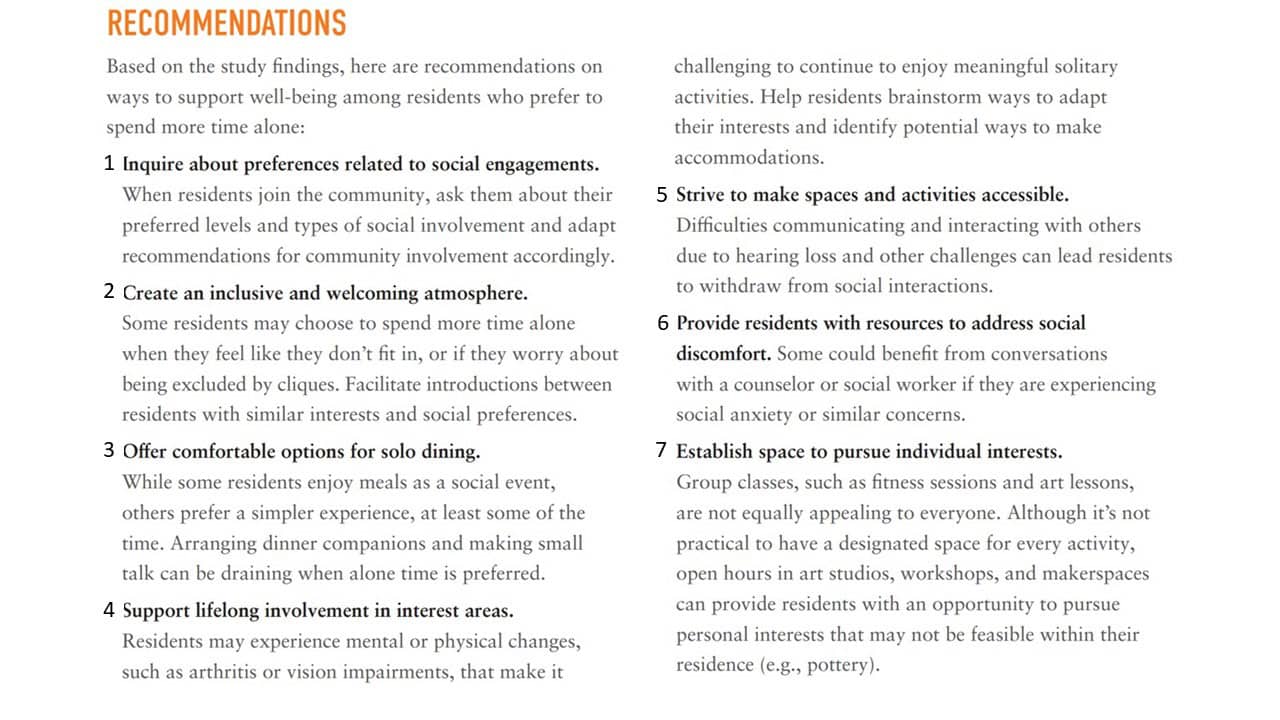 In terms of the survey recommendations above, I think RVM generally comes off well. For items 1 and 2, I suspect that results will depend mostly on the people assigned as hosts or ambassadors. If Marketing or Residential Services do not have mechanisms in place to guide newcomers to contacts that match their preferences, I think these would be worthwhile additions.
In terms of the survey recommendations above, I think RVM generally comes off well. For items 1 and 2, I suspect that results will depend mostly on the people assigned as hosts or ambassadors. If Marketing or Residential Services do not have mechanisms in place to guide newcomers to contacts that match their preferences, I think these would be worthwhile additions.
Item 3 is well fulfilled, and appreciated. Unless I am with close friends I prefer to eat alone, and rarely have any trouble doing so.
Items 4 and 5 are well addressed in terms of availability; promoting knowledge and use of the opportunities is challenging, and especially so with solitude seekers who have little interest in routine institutional communications. Item 6 is similar – having a counselor on staff is an excellent service, but making connections with those in need (the minority I refer to as the “unhappy loners,” plus those undergoing temporary situational stress) is an ongoing challenge.
Item 7 is very well served by the available fitness and craft areas, as well as our excellent library, and by the common areas.
Provision of “solitude-positive” opportunities and facilities is generally good. In terms of connecting with the relevant individuals, the study recommendations seem to be written for smaller institutions where one-to-one contact between management and residents is easier to set up and maintain. At the scale of RVM, the important suggestion for staff and resident community leaders is to remain aware of and sensitive to the existence and needs of the substantial subcommunity of Solitude Seekers – wheels that may not get enough grease because they choose not to squeak loudly.
A Closing Editorial:
In addition to my assessment of RVM as a relatively introvert-friendly place, I want to applaud the open-door policy of the current RVM administration. Committees and town-hall meetings can be useful, but they are not communication mechanisms that match the skills and preferences of introverts. One-to-one (or very small group) is better than group interactions, and for some people, written contact is much preferable.
These characteristics are often looked down upon by the more extroverted, I think in many cases because they simply don’t realize that these “different” behaviors are not flaws or pathological exceptions, but are basic characteristics of a third or more of the population. A greater realization of systematic personal differences can – and in my opinion should – lead to greater inclusiveness and diversity in community characteristics and processes.
With that brief background, some comments on the resident community interactions at RVM:
RVMlist – while I acknowledge that standards are needed, I think that the frequent admonitions to not discuss problems, but to take them to a committee represents an extroverted view of what the community is (or could be) and how it functions – or could function. Some people are not comfortable with other ways of communicating their concerns, and others do not want their views filtered and/or blended. We need better ways to welcome their contributions and respond to their concerns.
The “volunteer culture”– Introverts may be quite willing to make community contributions, if they can do it in the context of their own values and skill sets. Taking on somebody else’s job description for achieving somebody else’s goal may be neither satisfying nor enjoyable, and organizations don’t necessarily have to function that way.
Resident activities and governance — In my opinion, the Residents Council structure and procedures for non-financial inclusion and support of groups and activities are unnecessarily cumbersome and restrictive. I agree that accountability is needed where money is involved, but beyond that, I think that any resident activity initiative that is not inconsistent with RVM policies should be accepted and assisted to the extent possible. Possible approaches to this include transforming the Volunteer Opportunities operation to Volunteer Support, and/or adding the position of Communications Secretary to the Board (in addition to the Recording Secretary) to facilitate and assist with resident communications at all levels.
_______________________________________________________________________
Reaction? Interest? Response? Use the Reply feature below or send us a letter-to-editor at openinforvm@gmail.com
________________________________________________________________________
1World Health Organization: https://www.who.int/news-room/fact-sheets/detail/mental-health-of-older-adults.
2https://www.snhu.edu/about-us/newsroom/business/what-is-social-capital
3Seeking Solitude: Motivations for “Alone Time” among Senior Living Residents. J. L. Smith, V. Thomas, and M. Azmitia. Mather Institute (https://www.matherinstitute.com/), 2023. 12 pp
4Quiet: The Power of Introverts in a World That Can’t Stop Talking. S. Cain, Crown Publishers, NY, 2012. 333 pp.
Tom’s Beard and Other Information You Don’t Want to Know About Wild Turkeys
A Wild Turkey’s “beard” is the tuft that looks a bit like a miniature horsetail dangling from its breast. Year-old males (called “jakes”) have beards up to about five inches long, while toms three or more years old can have beards that are 10 inches or longer. Rarely, a tom will have one primary beard and one or two smaller beards just above it. About 5-10 percent of female turkeys may also sport short, thin beards. Many turkey hunters collect beards as trophies similar to deer and elk hunters collecting antlers — but the beards take up much less space.
The bristles in the cluster of stiff filaments are hair-like, but they are not hair. They are feather-like structures called mesofiloplumes. Their structural proteins are like feathers, but they lack a follicle and other characteristics of most feathers. Unlike feathers, turkey beards grow continuously.
The beard’s function is not known with certainty, but it might influence mate selection by hens. Longer beards signify older, healthier males and thus superior mates. Per Julie Craves, an ecologist and retired director of the Rouge River Bird Observatory in Dearborn, Michigan.
Spring jakes usually have 3- to 4-inch beards, though some early-hatched birds sport 5-inch beards. When a gobbler reaches 2, his beard is usually 8 to 10 inches. A beard gets its black color from melanin, a pigment that colors and strengthens feathers. The newly emerging beards of young turkeys contain little melanin, so the bristles are amber-colored. Even when a gobbler is 2, his beard will retain those original amber tips because they haven’t broken off yet. If you hold the beard of a 2-year-old gobbler under light, you’ll see the tips are mostly amber.
Some hens — maybe one in 20, depending on the location — also grow beards. Typically, hen beards are thin and measure 6 to 8 inches. From Brian Lovett’s Turkey & Turkey Hunting Blog

Full Beard
Color-Changing Head
Mood characterization is arguably more pronounced in wild turkeys than any other species of bird or mammal. With its head changing from red to white to blue, this distinct phenomenon is still not fully understood.
“Head color changes in males occur as birds become excited, agitated or otherwise change moods. We don’t fully understand what each color means, but there’s a fairly broad consensus amongst hunters that see birds often that red colors often signal irritation or fear. It is also believed that white on the top of the head serves as a form of signal, as that is often highly visible when males are excited and approaching hens” … From the National Wild Turkey Federation

Aren’t I grand?

Where are the bugs?
Who Pooped?
Yes, fresh turkey droppings can often be used to determine if the producer was male or female. Male turkey poop tends to be elongated or J-shaped, while the female’s is like a spiral blob, more or less similar to a snail’s shell. The contrasting configurations arise from the different internal anatomy of male and female turkeys. Many anatomical differences are common to all birds, but the males of some species, including turkeys, have a rudimentary internal sex organ. Since the structure is located close to the waste stream, it may influence the shape of droppings. Per Julie Craves

Tom’s Poop

Hen’s Pooop

Oh deer, is some sly hen trying to fool the peerless tracker?
The Fish and Game departments in several states that did not have turkeys were convinced to import some. Originally turkeys raised in game farms were released in the wild, but the birds did not survive since they hadn’t been taught how to find food. Eventually, success was achieved by trapping turkeys in Texas and Arizona for release in the new habitats. Texas turkeys were released in the Rogue Valley in 1975 and like typical Texans, soon multiplied and took over the territory.
A Texan turkey will flee as soon as it detects a human, but Oregon turkeys, when they are not shot at, will soon move into the “no hunting” areas or suburbs to share the suburban bounty that we all enjoy. (Extracts from Southern Oregon’s Bird Life by John Kemper)
What’s New in October
Interested in previous issues? Go to the News & Views page or the Arts & Info page. Scroll to the bottom of the page. In the center is a “Load More” link. Click this to display past articles.
NEWS & VIEWS
The Craft Fair is Coming, by Connie Kent
Mourning Lahaina – an Interview with Jill Engledow, by Joni Johnson
Clever Words for Clever People, contributed by Connie Kent
Sustainability Can Be Beautiful, by Anne Newins
Practice Evaluation on Horizon Lane – A Big Success, by Joni Johnson
ARTS & INFO
NIT WIT NEWZ – October 2023, by A. Looney
October in the Library: Quirky Characters, by Anne Newins
Campus Butterflies, by Robert Mumby
Stone Art, by Cathy Fitzpatrick – photo collage by Reina Lopez
Book Review: All the Beauty in the World, by Bonnie Tollefson
Events & Opportunities
Concerts and Performances October- December 2023, submitted by Mary Jane Morrison
Classes, Games, and Events submitted by Sarah Karnatz
in Big, Borrowed, or Both
3550: the Portland Mirabella quarterly magazine (most recent issue) Click Here
Mirabella Monthly, Newsletter of the Seattle Mirabella (September issue) Click Here
Mourning Lahaina- an Interview with Jill Engledow
By joni Johnson
“My friend lost her husband and her house in one night. How do you deal with that? Another friend helping to clear out dead wood, stepped into a hot spot and was taken to the hospital for multiple burn recovery. She was in Kula where another fire was burning at the same time.”
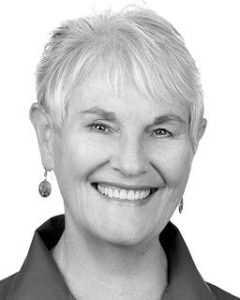
Jill Engledow
RVM resident, Jill Engledow told me this during a conversation we had in early September. This article is about Lahaina and the devastation created by the surprise fires of August 8, 2023. Jill has written four books about Hawaii. Among them is one called The Story of Lahaina. She knows Lahaina intimately. She was a reporter for the Maui News largely covering Lahaina and the surrounding areas in the 80’s. Then she turned to writing historical reports and worked with the Lahaina Restoration Foundation to do museum displays. All of Jill’s books are in the RVM Library.

Jill’s book on Lahaina
There is no way to keep up with all of the changes that have happened since the fire because stories are changing by the minute. However, Jill’s intimate experience with Lahaina over so many years can give us a special insight into what was and what might be. Two weeks have passed since the interview and one month will have passed by the time this article goes to print. So I will fill in some information not known at the time that we spoke.
The entire island is grieving. On September 1, all of the islands held vigils for all that was lost. They were all held three times, morning, noon and sunset, and, depending on the location, they consisted of hula and other musical tributes as well as interfaith ceremonies. But that was only one day. Jill says there is an enormous pall all over the island. People are hugging and sharing their loss. Therapists are offering their services. And activities for children to help promote recovery are taking place.

Lahaina aerial photo after fire
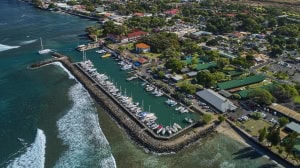
Lahaina Harbor-Before

Lahaina Harbor- After
From Jill’s perspective, because of new laws and regulations developed after Lahaina was built, the old town can never be rebuilt the way it was. The town is largely a town with narrow streets and no sidewalks. A lot of the Front Street buildings were built on the shore-line, even extending out into the ocean on stilts. With sea-rise happening, there are new setback regulations. Jill thinks that one alternative would be to build uphill where there is plenty of room. On one side of the road uphill, there were a number of structures and other houses. Some of them escaped serious damage in the fire. Luckily, the Lahainaluna High School, which had originally been built in the early 1800’s as a seminary for Hawaiian men and finally a public high school, is still standing but closed. Another RVM connection here is that Arnold Lum’s father was the farm manager and boarding supervisor at Lahainaluna from 1926 to 1944.
However, Hale Mahaolu Eono senior-living complex, burned down. People were able to live there in a one bedroom palm-fringed apartment overlooking the Pacific. Because the housing was subsidized, the cost could be only $150 per month. They held group barbecues and monthly birthday celebrations much like the Manor. They felt like they had found stability on an island where many elders — known in Hawaiian as “kupuna” — had been priced out after a lifetime of raising families and serving tourists. Now, the housing complex is rubble. So some buildings will need to be rebuilt, while others remain standing just like they did in the Almeda Fire. However, the other side of the street is largely open and available. There is a very strong feeling in Hawaii that the residents of Lahaina should decide how their town should be rebuilt, and Jill agrees with this. For the latest news on rebuilding check out this article which talks about the latest in setting up community meetings:

Banyan Tree is coming back to life
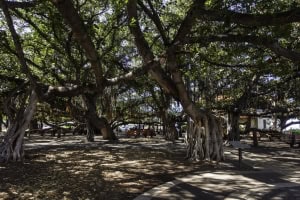
Banyan Tree- Before
Another important issue is water. Lahaina was built on wetlands with streams and ponds. However, starting in the 1800’s, the pineapple plantations began changing the water flow, and it has never returned to its former glory. Much of the water in Lahaina comes from wells. A water rights activist has said that those in the Lahaina area can safely draw 500 millions of gallons a day. This is what is currently being drawn. Restoring the surface water would replenish the aquifer.
How Lahaina will rebuild itself is still unknown. Most people still can’t get to their houses because of the toxic waste and unsafe buildings. From one article I read, they have managed to clean up 15% so far.
A look at how other communities have dealt with similar calamities is instructive. In Hilo, after a tsunami, the state took over the whole lower section and made it into a big memorial park. Crescent City got their city back in about two years after the Tsunami of 1964, which started as a 9.2 earthquake in Alaska. Twenty-nine city blocks were devastated.
After the Loma Prieta earthquake in 1989, Santa Cruz managed to rebuild much of its downtown area in four years. In 2011, 22 years after the earthquake, Nikki MacDonald wrote, “The first impulse after a disaster is to put everything back the way it was. You can’t do that. The first thing that has to happen is that people have to get that. Not just intellectually, but emotionally.” A school gym was set up with tables of eight for a three-day design symposium. Santa Cruz locals discussed, drew, and then presented their central city concept. One group wanted a little Venice, with canals instead of streets.
“That [the symposium] was a brilliant idea,” says Pacific Cookie Company owner Larry Pearson, who lost his Pacific Ave flagship store and doughmaking facility in the quake. “It allowed everybody an outlet for all these feelings they had. People were just pent up with very strong opinions, because people cared so much. People got to see their ideas actually represented, and to see people’s reactions to them.”
Currently, Summer Sylva, the senior advisor for Native Hawaiian Affairs in the U.S. Department of the Interior, has been assigned to FEMA’s Cultural Protocol Task Force to ensure that the federal response to the devastation is sensitive to the needs of the community.
Sylva, who is kanaka maoli, a Native Hawaiian with roots in Lahaina, said the destruction has highlighted the longstanding tensions between Hawaii residents and the federal government, especially when it comes to the land and how it’s treated, she told ABC News.
So now there are many interests and forces trying to determine the fate of Lahaina. It all will take time to play out. Meanwhile, shortly after Jill and I spoke, she left for Maui hoping to help in any way possible. “It will always be home to me, no matter where I live.”
Sustainability Can Be Beautiful
Recognizing and Accepting Climate Change
by Anne Newins
Many Manor residents were attracted to Southern Oregon because of our beautiful mountains, forests, waterfalls, and lakes, especially if we came from flatter and drier climes. Little did we know that climate change was going to rear its ugly head in the form of reduced rainfall and snowpacks, which in turn have had negative impacts on both flora and fauna. Locally, Douglas fir, rhododendron, and azaleas all are demonstrating the negative effects of prolonged drought and higher temperatures. The susceptibility to fires has heightened, as we saw on our own campus on August 16, 2023.
When I moved here eight and half years ago, the average rainfall was predicted to be 18.4 inches per year. Out of curiosity, I checked to see how often this has occurred. An interesting website providing historical records of Medford’s weather (https://www.extremeweatherwatch.com/) revealed that the predicted annual rainfall has only happened three of the last nine years, last occurring in 2019. As of September 30, the year-to-date total for 2023 is only 8.60 inches according to the National Weather Service. I am not optimistic that we will have another ten inches of rain by the end of this year.
Snowfall obviously affects our water availability, but is more difficult to calculate since it comes from various locations, including Mt. McLaughlin. Residents have seen that snowpacks can be meager. The long-range forecast for this winter predicts another El Niño, which often results in reduced rainfall in the Pacific North West.
So, what to do at Rogue Valley Manor?
Fortunately, both residents and RVM employees have been concerned about this issue for several years. In 2021, the Landscape and Grounds Advisory Committee sent a memo to then Executive Director Stan Solmonson expressing the following goals:
- Transition to lower water use,
- Use more sustainable plantings,
- Fire risk mitigation.
The complete memo is attached below.
Jody Willis, the current committee chairperson, and a Jackson County Master Gardener, believes that “People need to be open minded. Landscaping using drought tolerant and native plants can be beautiful. Residents need to understand that like any other type of landscaping, sustainable gardens take a few years to mature.”
Jody pointed out that this type of landscaping does not need to be boring or barren. Pictured below are some examples of attractive gardens. As Jody said, “Lawn covered areas can be slowly reduced. Gardeners can gradually begin incorporating more climate friendly plants. An added benefit of these species is that they often attract beneficial insects.”

A dramatic sustainable hillside
Well-versed in this type of landscaping, Jody provided me with a long list of nurseries and resources, which includes the Shooting Star Nursery, a Central Point business familiar to Manor residents and often used by the Grounds Department. Plant Oregon, in Talent, offers many larger species. Readers interested in a variety of gardens can view several examples posted on the Jackson County Master Gardeners native gardens page: https://jacksoncountymga.org/native-plants-garden-tour/.
RVM’s Strategic Plan and Sustainability
Executive Director Dave Keaton recently presented RVM’s new strategic plan. Many residents were pleased to see that Strategic Plan Goal #13 includes the need for sustainability, which outlined two phases.

Isn’t this more interesting than lawn?
The Phase 1 goal is to create a plan, with a six-to-nine-month time line, that includes the selection of “a sustainability consultant to develop a campus wide plan for multiple operating areas including landscaping, HVAC and utilities with the goal of increasing sustainability and lowering future operating costs.” The Phase 2 goal, with a six-month time line, is to create an implementation plan, which will “help create opportunities to institutionalize the execution of the sustainable plan and will involve participation of multiple groups.”
What will it take to convert to sustainability?
Facilities Director Drew Gilliland will play a crucial role in the development and implementation of a sustainability plan. Drew believes in following “best practices, which should include good water conservation.” The need for water conservation is both ethical and pragmatic for Drew. Although RVM has high ranking water rights to Bear Creek, which provides the bulk of our landscape irrigation water at a low cost, he also believes that “we need to be good neighbors to the city of Medford.” Using large amounts of water that result in reduced availability for others is unprincipled.

A lovely garden on nearby Creekside Drive
From a pragmatic perspective, RVM paid $57,461.73 over the past year for the domestic water that is used in our homes. Drew anticipates that water bills may double or triple over the coming years as the city invests in improved infrastructure and as a motivational tool to encourage residents to use less water. The City of Medford has several programs encouraging home owners to convert sod to water saving landscaping. The Manor is participating in the City’s lawn reduction program. For example, lawns in front of cottages could be converted over time to lower water usage landscaping, due either to changes in residents or by resident requests.
Drew also would like to see some wide swaths of grass be converted, perhaps with new walking paths installed. Besides reducing water use, they would be less expensive to maintain. He is a staunch supporter of native plants, although he believes that some non-native drought tolerant plants might be suitable.
In conclusion, the notion that RVM can continue using the same landscaping practices indefinitely is not realistic. We can plan for a more sustainable and appealing landscape, which will take time and creative planning. The other alternative would be for us to figuratively leave our heads in the sod until water becomes so limited that we are left with large spans of dying plants and grass.
Attachment: Sustainability Memo from Landscape and Grounds Advisory Committee, 2021
To: Stan Solmonson, Executive Director, Rogue Valley Manor
From: Landscape & Grounds Advisory Committee
Subject: Goals for Sustainability for RVM Campus
The Landscape & Grounds Advisory Committee recommends that the following concerns and actions be incorporated into future planning for our campus.
We all value the beauty of our campus, and the landscape and grounds are the reason many of us chose to move here. Maintaining the beauty and encouraging others to choose to move here while fulfilling our responsibility to environmental sustainability is our overall goal.
Our goals are the following:
- Transition to lower water use. Complete a thorough evaluation of the campus irrigation system, with particular attention to reducing overall water usage, leakage and waste. Once completed, implement a technologically efficient plan to incorporate the recommended changes. Consider SMART systems that adapt to different water needs for each unit, rather than entire buildings.
- Use more sustainable plantings. Transition to plantings and trees that are eco-friendly and drought tolerant. Reduce areas of grass or use more drought-tolerant grass. Replace some annuals with drought-tolerant perennials, especially native plants. Plant selection should reflect beauty, biodiversity and sustainability. Reduce chemical use by utilizing natural pest control and fertilizers.
- Fire risk mitigation. Include fire resistant plantings and design in new landscaping. Reduce flammable plantings near cottages when possible. Continue to clear debris and dead lower limbs of trees especially in the most vulnerable areas of campus.
Our future depends on addressing these concerns.
Thank you.
Landscape & Grounds Advisory Committee
Linda Spence, Chairman; Ken Kelley, Fred Moore, Anne Newins, Barbara Maxfield and Jody Willis.


